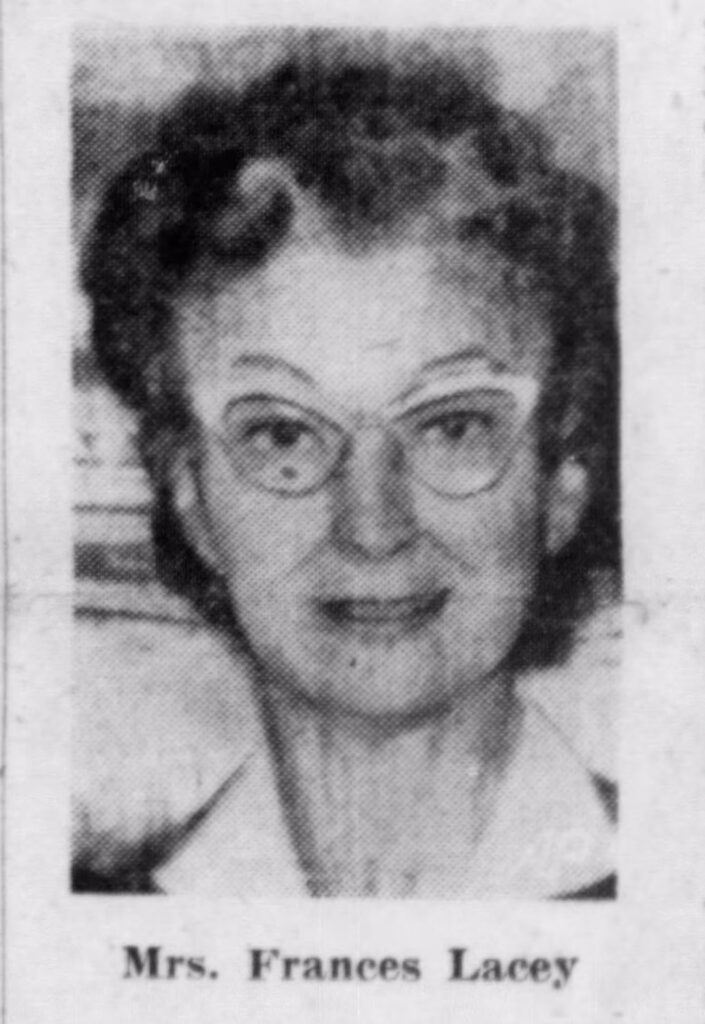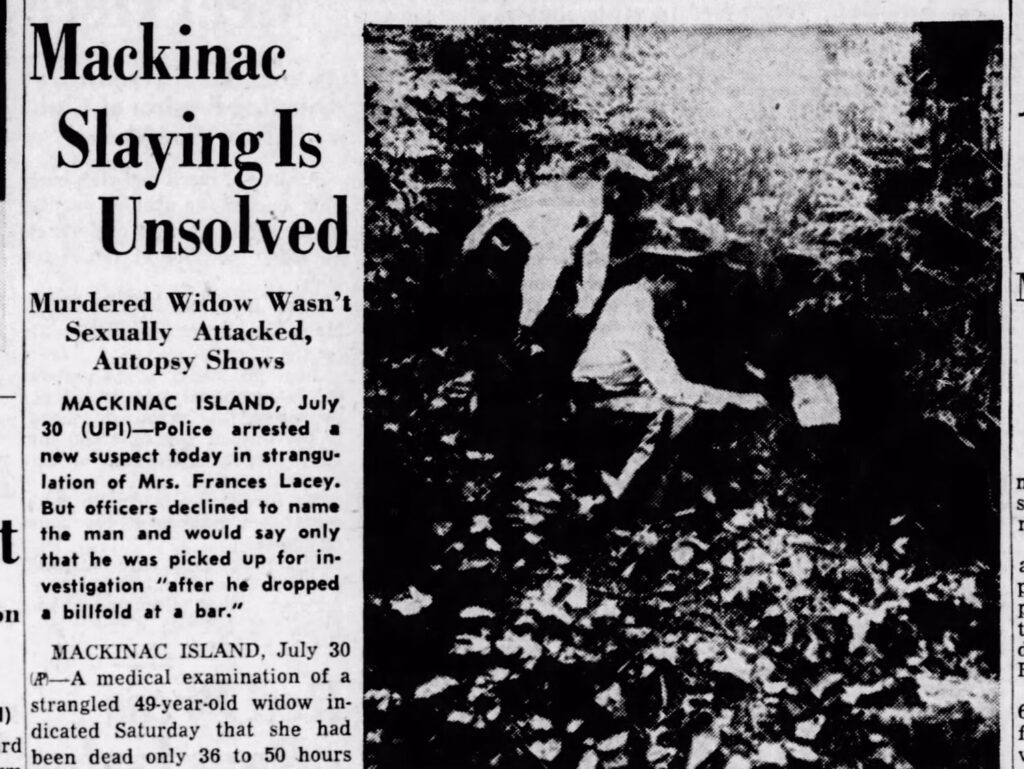What Michigander hasn’t spent time on Mackinac Island? We come here to ride our bikes around the island. We come here to eat fudge and sip tea at the Grand. We come to observe summer sunsets and watch boats sail under the bridge. We don’t come here to get murdered.
And neither did Frances Lacey in the summer of 1960.
Those who knew her described Frances as a kind, quiet woman who mowed her own lawn and kept up her home. The 49-year-old widow from Dearborn was spending a few idle days on Mackinac Island with family.

In the morning on July 24, 1960, Frances set out to walk across the island from the Murray Hotel, where she was staying, to visit her daughter Kay Sutter and her son-in-law Wesley Sutter, who were holidaying at a cottage near British Landing.
The trek was about three and a half miles, but by 11:00 a.m., Frances had not arrived. Her daughter contacted the Michigan State Police on the island right away and a search began.
Because the island is small and crisscrossed with roads and trails, it seemed certain that she would be found quickly. A massive search ensued, harnessing the efforts of over 60 people, including State Police, Coast Guard, Boy Scouts, State Park employees, residents, and bloodhounds.
Even with this amount of manpower, it took 72 hours to locate Frances. Her body was found off the ring road that circles the island, hidden in thick brush. The medical examination proved her death was a homicide. Pieces of her dental plate were found on the paved road. As was a pink Scripto pen.
As investigators moved into the brush, they found her size 6 shoes under an old rowboat. Further into the scene, Frances’s body was discovered under branches and sticks that had been piled on top of her to hide her.

The idyllic island was shaken with fear and dread. No one had ever been murdered on Mackinac before.
Dr. Gene Webster of Petoskey, the presiding medical examiner, in his post-mortem revealed bruising on the left side of her chin, a laceration on the upper-left side of her head, a deeper laceration on the left side of the head near the temple, and bruising on the left clavicle and her panties tightly knotted around her neck.
Webster believed she had been hit from behind by blunt force, then strangled by hand and finally asphyxiated with her underwear tied around her neck. He also found evidence of sperm in vaginal smears which, because she was a widow and not prone to promiscuity, indicate sexual assault.
A blondish-light brown hair not belonging to Frances was found in the front of her slip. Due to lack of forensic testing in 1960 and the loss of this evidence in later years, this hair has never been identified.
Also missing from Lacey was her purse and her watch.
The missing purse was one of the first things that went wrong in the investigation. The morning Lacey was killed, a couple biking on the west side of the island found a purse on Lake Shore Road. They looked inside, saw Lacey’s ID and brochures from the Chippewa Hotel. They assumed she was staying there, but since she wasn’t, the hotel rejected the item.
The couple thought the woman had perhaps left the island already. They lived in Detroit, and they could see Frances was from Dearborn. They decided they would take it home with them and deliver it personally to Frances, who they were sure had left the island already.

Four days later, after the couple was in Detroit, Frances’s murder was announced in the national news. The couple contacted the police and gave them the location where they found the purse. Had the purse been handed over to the police sooner, evidence may have hastened the search or provided other evidence, like fingerprints on the purse, that could have helped identify the assailant.
As for the missing watch, it’s never been found. Investigators surmise it might have been taken or hidden by her killer.
Why was Frances a victim? Most who have studied the case believe Lacey’s murder was an opportunistic crime. The killer saw her alone and took advantage of the situation to rape and kill her. Where things get murky is the theories about who would have done it.
“Some former and current officials believe it was an insurance hit, so the family could get a payoff. Some believe it was an islander,” said Rod Sadler, a seasoned Michigan law enforcement veteran who retired in 2012, and picked up the Lacey cold case decades to write a true crime book about it titled “Grim Paradise: The Cold Case Search For The Mackinac Island Killer.”
Sadler doesn’t think either of those theories hold water: “I don’t believe that someone on the island would keep that secret for 65 years.”
In his research for the book and efforts to solve the case, Sadler studied thousands of pages of police reports, combed through the remaining evidence, and talked to anyone connected with the case.
At the time of the book’s release in 2023, he stated on his publisher’s blog: “I believe the murder of Frances Lacey involves a killer who, for forty years after her death, sharpened his skill and that, perhaps, Frances Lacey’s murder was the genesis of his murderous career.”
Sadler now posits there are three legitimate suspects in the Lacey murder. Including a brand new one that surfaced earlier this year.

The first suspect, according to Sadler, is Jerald Leroy Wingeart, a well-documented accused rapist and killer from Michigan. His first rape conviction was in 1961. He was married and studying engineering at the University of Michigan at the time. He served his prison sentence, returning to society in 1969, and took a job as a long haul trucker and then later became a computer programmer, settling down in Eaton Rapids in 1973.
It wasn’t until 2001, at age 60, when he was accused and sentenced for the murder of Dawn Lee Magyar in 1973. At this same time, he was under investigation for the deaths of other young women in Washtenaw and Ionia counties, including Laura McVeigh.

At the time of Lacey’s murder, Wingeart was a tall, blond 19-year-old—exactly the type of man several witnesses said they saw around the time of Lacey’s disappearance. Wingeart died in prison in August 2022.
The second suspect is a man named Cleon Brown. Brown was interviewed by police twice in 1960. In a supplemental report of the main police report, it was discussed that Brown passed a polygraph, but that hair taken from his body matched one of Lacey’s hairs.
And in his first interview with police, Brown admitted to being on Mackinac Island during the time of the murder. However, when Brown was questioned a second time, he changed his story about which island he had been visiting, denying he was on Mackinac.
The last suspect is linked to a new lead Sadler received in March of 2025 when he received an email with the subject line: “DNA.” The message inside was simple and direct: “We need to talk.”
The man who sent the message lives in North Carolina. He and Sadler connected further via a phone call.
“He told me that after hearing a podcast about the Lacey case, the hairs on his neck went up,” said Sadler. “He believes his blood relative, who passed away in 1975, was Lacey’s killer. Based on the supporting documentation of an account provided to me from this gentleman, I think there’s something to explore here.”
While Sadler can’t reveal too much about the details of this interaction, he said, “There’s something dark in the history of this blood relative. There was a secret known to this person, but kept until their death. I have original documentation written by this gentleman’s grandfather to prove it.”
Sadler also believes that if he could find the evidence of that hair that was on Lacey, he could create a DNA profile to compare the sample with this man who contacted him and see if it’s a genetic match.

Now, the question remains, can he find the evidence to pursue solving this case? This task may prove herculean due to decades-old poor record keeping.
“A couple of lab people from the Michigan State University lab reached out to me after ‘Grim Paradise’ was published and explained to me how trace evidence was kept in the 1960s,” said Sadler.
At the time of Lacey’s death, trace evidence was sent to the Criminal Detection Laboratory (CDL), and fastened on slides. Those slides would be placed in large manilla envelopes with the complaint numbers written on the outside of the envelope.
Each envelope sat in a vertical file next to the lab techs. As comparison samples entered the lab, the techs would look through those envelopes for the correct complaint number, pull out the evidence to do the comparison, and then put the folder back. None of the criminal evidence was secure and locked in a drawer.
Another obstacle? The CDL no longer exists.
The Michigan’s Criminal Detection Laboratory used to be a part of the Michigan Department of Public Health. The lab was not located at the East Lansing Police Post, as it is now. It was housed in a large brick building on Logan Street, known today as Martin Luther King Boulevard. In the mid-1970s, the crime lab became part of the Michigan state police post and was moved to that location in Lansing.
This leaves Sadler wondering, did all the evidence from the brick building get transferred to the new post? Or did some get left behind, damaged, tossed, or destroyed?
He has good reason to question.
“I met a cold case detective who showed me three or four plastic tote boxes. He said the crime lab called him up and didn’t know what was in the boxes,” Sadler said. “Turns out, it was criminal case evidence from the 1930-60s, from all over the state. They asked him if he was interested in having it. Of course, he was! He went through and cataloged everything.”
The Lacey evidence was not in there.
“I’m just wondering if there’s other evidence like that sitting in boxes that no one knows about?” said Sadler. “The Lacey evidence could still exist, in boxes of old slides and old cases that were never transferred from the Criminal Detection Lab to the new state police lab.”
Sadler thinks this might explain why the trace evidence of hair taken off Lacey’s body and the panties are missing.

“It is not uncommon for evidence to be lost or destroyed. Whether intentionally or accidentally. There could be other factors involved, too,” Sadler said. “There may have been property room damage, flooding issues, or maybe a new guy gets hired in the property room and his boss asks him to clean it out. This new guy may have no idea what these old cases are and he may have decided to clean them out to make room for the newer cases. It happens.”
Sadler has meager hopes that the Michigan Department of Public Health can help him find missing archived evidence from the Lacey case because it’s an open homicide case.
“In order to search for the missing evidence, they would need to find the manpower and time to do it. That’s going to be difficult,” Sadler said. “I’m the only person trying to solve this case.”
But Sadler is not about to give up. He suggested he might reach out to the Cold Case Foundation to see if they can offer advice or assistance with finding those lost files. He is also slowly compiling documentation to present to the Michigan State Police.
One day, perhaps soon, Lacey, her family, and Mackinac Island, may get the answers and closure they have been waiting for over 65 years.
Read more about the Lacey case in Sadler’s true crime book, “Grim Paradise.“
Jennifer Dornbush is an author, screenwriter, speaker, and forensic specialist. She has developed film and TV projects, authored numerous books, and frequently speaks around the world on crime fiction and forensics. Her next novel, released October 28, 2025, “What Darkness Does,” was inspired by the true crime case of Michigan murderer, Marvin Gabrion. Connect with her at: www.jenniferdornbush.com.



